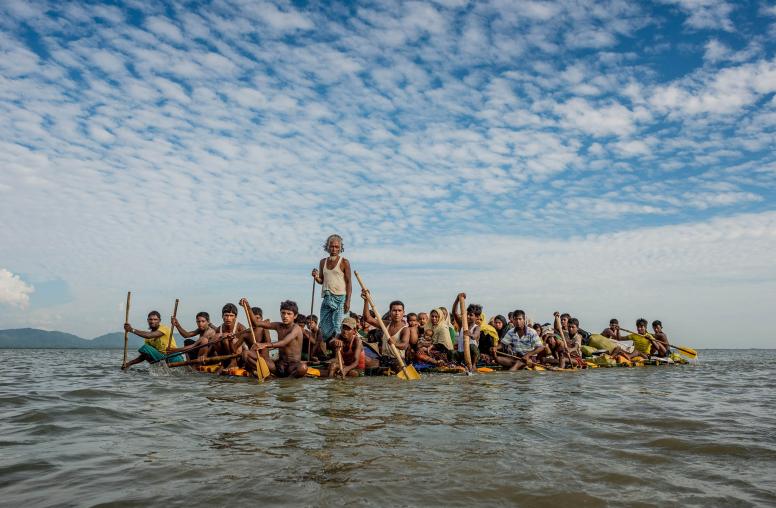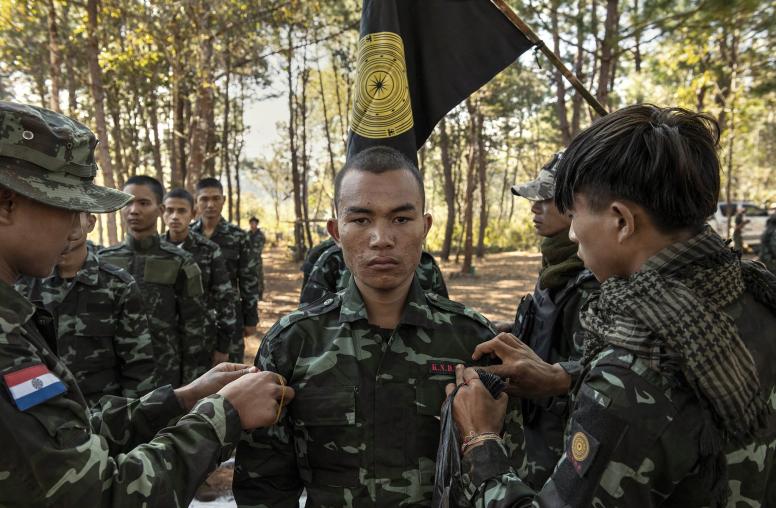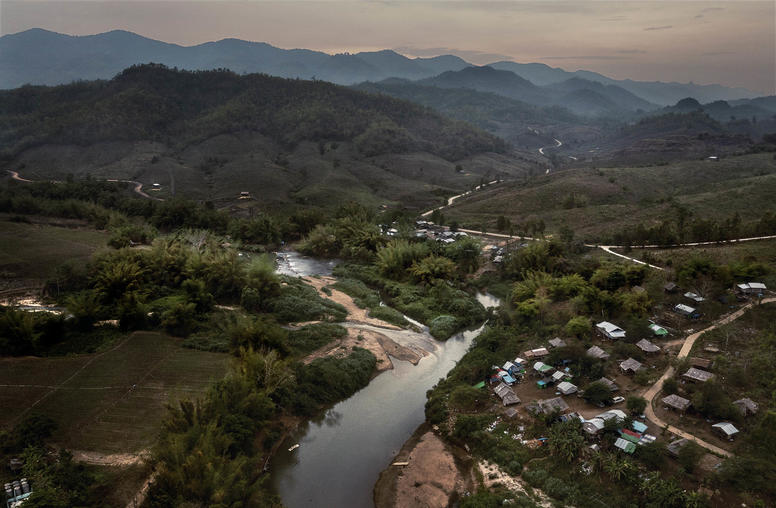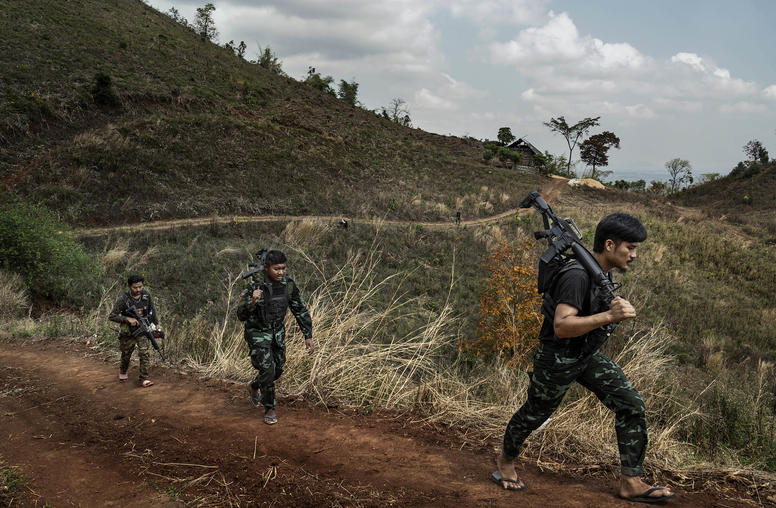Time is Running Out for India’s Balancing Act on the Myanmar Border
Washington should encourage New Delhi to support Myanmar’s pro-democracy movement as the best path to stability.
India has had a simmering crisis on its northeastern border since the Myanmar military’s February 2021 coup d’état. Over 50,000 civilians have fled across the border from Myanmar’s Chin State and Sagaing Region into India’s northeast. New Delhi has maintained a delicate balancing act, allowing refugees into the country but refraining from political pressure on the junta and its State Administrative Council (SAC). However, as the situation in Myanmar continues to worsen, India will need to rethink its position before the fallout seriously threatens its interests.

With Indian Prime Minister Narendra Modi heading to Washington later this month, the United States should seize the moment to enhance engagement with India on Myanmar and work to alleviate the humanitarian situation and support for the Myanmar resistance’s effort to establish a federal democracy.
The Northeastern Front
U.S. engagement must be grounded in the understanding that India’s Myanmar policy is driven by geopolitics and its concerns about its border areas.
A glance at the map shows that India’s eight northeast states are connected to the rest of the country by only a thin strip of land, known as the Siliguri Corridor. The region shares a 994-mile-long border with Myanmar, and the Indian communities of Mizoram, Manipur and Nagaland have ethnic and kinship ties extending into Myanmar’s Chin State and Sagaing Region. New Delhi sees the Myanmar military as a partner for controlling the border and denying safe haven to Indian rebel groups.
The Myanmar military’s dysfunctional rule has cultivated an environment where porous borders and armed groups in the hinterland are the norm. Far from denying territory to Indian rebels, the junta is offering them sanctuary in Myanmar in return for fighting the pro-democracy People’s Defense Forces and ethnic revolutionary organizations (EROs) in Sagaing Region. The People’s Liberation Army of Manipur and Manipur Naga People’s Front — which are fighting the Indian state for separatism or greater autonomy — have used Myanmar territory as a staging ground for attacks in India, including a November 2021 ambush on a convoy of the Assam Rifles, an Indian government-controlled paramilitary force. As evidence of this quiet collaboration, the Myanmar military has withdrawn from the key Indian rebel base it had cleared and occupied at Taga, Sagaing, leaving the site free for their use.
How China Factors In
Due to geography, Myanmar figures prominently in several dimensions of India’s geopolitical rivalry with China. China claims parts of India’s northeast. Beijing threatened the Siliguri Corridor in the 2017 Doklam standoff and clashed with border guards at Tawang in the Indian state of Arunachal Pradesh in December 2022. On April 2, 2023, China’s Ministry of Civil Affairs issued a statement that included Arunachal Pradesh as part of “southern Tibet,” spurring Indian diplomatic protests.
Myanmar is also an essential node for Chinese expansion into the Indian Ocean, most notably through the China-Myanmar Economic Corridor’s pipelines and planned railroads from Yunnan Province to Kyaukpyu Port. India fears that a weak SAC may become too dependent on China, opening new fronts for pressure and Chinese power projection.
However, China is already taking advantage of the post-coup landscape to increase its influence, pledging support to the SAC “no matter how the situation changes” while simultaneously stepping up engagement with its allies among the EROs. Since the coup, China has launched a number of new infrastructure projects in Myanmar, transferred jets to the military, and reached a deal for Yunnan Province to provide the SAC with rice and fertilizer. In April, Indian officials confronted the SAC over possible Chinese intelligence facilities on Myanmar’s Coco Islands, which would provide new capabilities for monitoring naval bases and missile test sites on India’s eastern coastline. If India’s accommodation of the SAC is intended to limit Chinese influence, it appears to not be working.
Look East, Act East
Despite working to appear uninvolved in Myanmar’s internal politics, India remains committed to its pre-coup investments and economic ties in the country. These projects were part of the Look East and Act East policies, which sought to increase India’s engagement with Southeast Asia.
Chief among them is the Kaladan Multi-Modal Transit Transport Project, which is meant to extend from India down into Myanmar’s Rakhine State and the Indian Ocean. While the Indian-funded port of Sittwe has begun operations, the planned 68-mile highway stretching through Chin State remains unfinished. Much of this area is in conflict and controlled by EROs, and completion of the project will require negotiations with them.
Indian companies continue to provide essential material support to the SAC. India was the third-largest supplier of arms to Myanmar before the coup, and NGOs report that India has supplied the SAC with weapons on at least four occasions since. In March 2023, rights groups Amnesty International and Global Witness further identified an Indian company and fuel terminal involved in the sale of jet fuel to the junta, which has used airstrikes to terrorize the civilian population. According to the U.N., these sales from Indian firms amount to $51 million in weapons and materiel for the junta since February 2021.
Worsening Situation in Chin State
New developments call India’s policy on Myanmar into question. The fighting is not winding down but intensifying, with about 1.5 million people internally displaced and the military increasing its use of airstrikes on civilian population centers.
Chin State, directly on the border with India’s Mizoram State, is a particularly intense battleground. The state has seen close coordination between the Chinland Defense Force and Chin National Army in their fight against the military, including the establishment of the Chinland Joint Defense Committee, which encompasses 18 Chin groups.
Throughout late 2021 and early 2022, the military conducted a major arson campaign, burning 1,400 houses and 13 churches in the strategic town of Thantlang and displacing the entire population.
On February 2, 2023, the military declared martial law in 37 of Myanmar’s townships, including seven of the nine Chin townships. In the past few weeks, military airstrikes killed eight civilians in Khuafo village and nine civilians in Webula. Crucially, neither town had been the site of recent fighting.
The conflict took on another dangerous transnational dimension earlier this year. On January 10 and 11, three SAC Yak-130s and two MIG 29s carried out airstrikes on Camp Victoria, the headquarters of the Chin National Front. The strike destroyed civilian shelters and medical facilities, forcing a renewed surge of hundreds of refugees. Local sources report that two bombs landed on the Indian side of the border, which New Delhi denies. The Indian Ministry of External Affairs has “taken up” the attack with the SAC, and the NGO Coordination Committee, which represents Mizoram’s leading civil society groups, has urged a stronger response from the Indian government.
Despite New Delhi’s anti-refugee rhetoric, UNHCR reports that there are about 40,150 Chin refugees in Mizoram and 8,250 in Manipur, with an additional 5,092 seeking registration with UNHCR in New Delhi. Mizoram’s state government has welcomed them, providing temporary identity cards, food, medicine and access to education. In February, the Mizoram Legislative Assembly adopted a resolution pledging to continue aiding the refugees.
At the same time, the Indian government has been reluctant to allow access for U.N. agencies in the northeast. No U.N. presence means that refugees cannot register with UNHCR for protection from forced return. It also means that Chin refugees lack access to humanitarian assistance and food aid from UNICEF and the World Food Programme. Civil society groups including the Central Young Mizo Association and local churches are filling the gap, but a common refrain is that the host community has “open arms, but empty pockets.”
Strengthening U.S.-Indian Cooperation
Until now, India has not put public pressure on the SAC to stop the violence either bilaterally or in multilateral forums; in fact, India abstained from U.N. Security Council Resolution 2669 (2022), which called for an immediate end to the fighting. Given the worsening conflict on its border, however, there may be an opening for the United States to engage India through a multi-pronged approach grounded in shared values and interests.
First, the United States and India enjoy a strengthening relationship ranging from security cooperation to anti-COVID efforts. Modi’s visit to Washington this month marks an opportunity to encourage a greater Indian role in resolving Myanmar’s humanitarian and political crisis. While aid for refugees and internally displaced persons is one pressing concern, the United States should also urge India to more forcefully call for an end to the violence and express support for the pro-democracy movement.
Second, the United States should offer support to address India’s security concerns in the northeast. The White House’s April 4, 2023 statement rejecting China’s claims on Arunachal Pradesh and recognizing it as Indian territory is a positive step, and intelligence cooperation has the proven potential to transform how India responds to Chinese pressure tactics. More broadly, Washington should emphasize to New Delhi that a more assertive stance on Myanmar will blunt the expansion of Chinese influence.
Third, the U.S. Congress has shown real leadership on Myanmar, authorizing $136 million in funding for pro-democracy groups and humanitarian aid with the BURMA Act of 2022. A constructive next step would be congressional engagement with India’s parliament to better understand the needs of refugees and prospects for cross-border aid.
With its history of border clashes, India knows the importance of having stable, peaceful neighbors. In an unprecedented fashion, Myanmar’s resistance movement is uniting ethnic minorities and Burmans in the fight for a federal democracy. As Asia’s largest multi-ethnic federal democracy, India should support this effort. It’s the best chance to prevent future instability on Indian borders.
Zo Tum Hmung and John Indergaard are the executive director and project and advocacy coordinator, respectively, of the Chin Association of Maryland.



